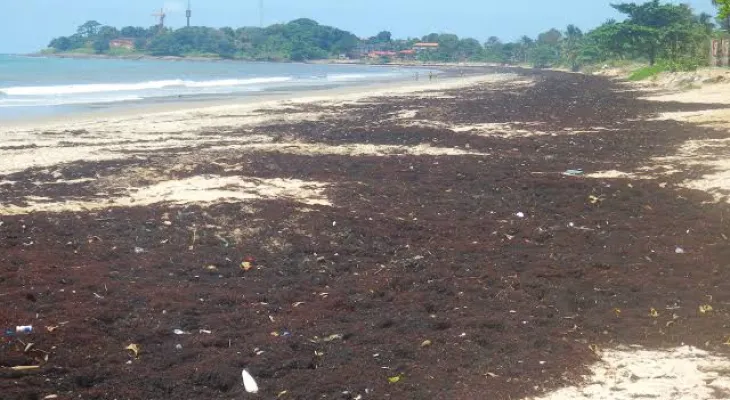
Seaweed Returns to Sierra Leone’s Coastal Beaches
Lumley Aberdeen Beach, a popular weekend destination, is currently covered in a thick layer of seaweed, turning the once tranquil shore into a vast green landscape. This recurring natural event has raised concerns and curiosity among both residents and visitors.
As dawn breaks over the peninsula, the expected peaceful beach scene is disrupted by large mounds of seaweed. The golden sands are now hidden under dense, brown algae stretching for miles along the shore. The strong smell of decaying seaweed permeates the air, reminding everyone of the natural processes behind this phenomenon. For those visiting the beach, the return of the seaweed is more than just a visual and sensory inconvenience; it disrupts their treasured weekend routines and tests their resilience.
“I’ve been coming to Lumley Beach every weekend for the past three years,” says Michael Kamara, a local football enthusiast. “This is the first time I’ve seen it like this. We had to spend over 30 minutes clearing this area just to play our Sunday football match. It’s definitely not the fun day at the beach we were hoping for.”
The seaweed invasion, which first occurred in 2011, has led to various theories about its cause. Some initially attributed the algae blooms to offshore oil drilling and mining. However, environmental experts have since clarified that these activities are not responsible.
Research from 2011 indicates that this phenomenon is natural, noting that while high nutrient levels in coastal waters promote algae growth, this occurrence is not linked to mining or exploration activities, as similar events have been observed in other countries.
The seaweed covering Sierra Leone’s beaches is primarily brown algae, known as Phaeophyta. These large, dense mats of seaweed create a unique habitat for marine life, but they pose a significant inconvenience for beachgoers. “The beach used to be so inviting,” says Fatmata Kamara, a regular visitor. “Now, it’s covered in seaweed and smells terrible.”
Despite the challenges, some are finding ways to adapt. John Bangura, a resident and beach lover, remains optimistic. “Sure, it’s a hassle to navigate through the seaweed, but there’s still something special about being here,” he says. “It’s part of nature and reminds us that the environment is always changing.”
Mariama Sorje, a mother enjoying a day out with her children, adds, “We couldn’t let the seaweed ruin our day. The kids had fun collecting bits of seaweed for their own creations. It’s not what we expected, but we made the most of it.”
Environmental researchers have noted that the influx of seaweed is linked to high nutrient levels along the shores, which foster algae growth. This natural process, while inconvenient for beachgoers, plays a vital role in coastal ecosystems.
As the seaweed continues to accumulate, the beach community remains hopeful for a resolution. For now, Lumley Aberdeen Beach serves as a vivid reminder of nature’s power and the resilience of those who cherish its shores.
“Seaweed or not, this is our beach,” says Abdul Sesay, a long-time beachgoer. “We’ve adapted and keep coming back. It’s part of the beauty and unpredictability of nature.”
As the sun sets on another day at the beach, the seaweed-covered sands offer a moment of reflection on the delicate balance between human enjoyment and the natural world.




















